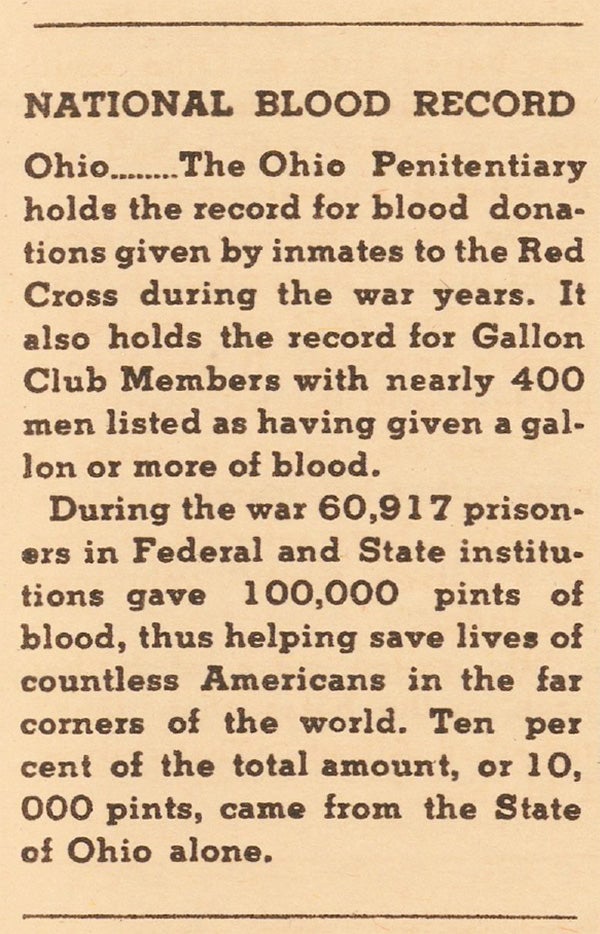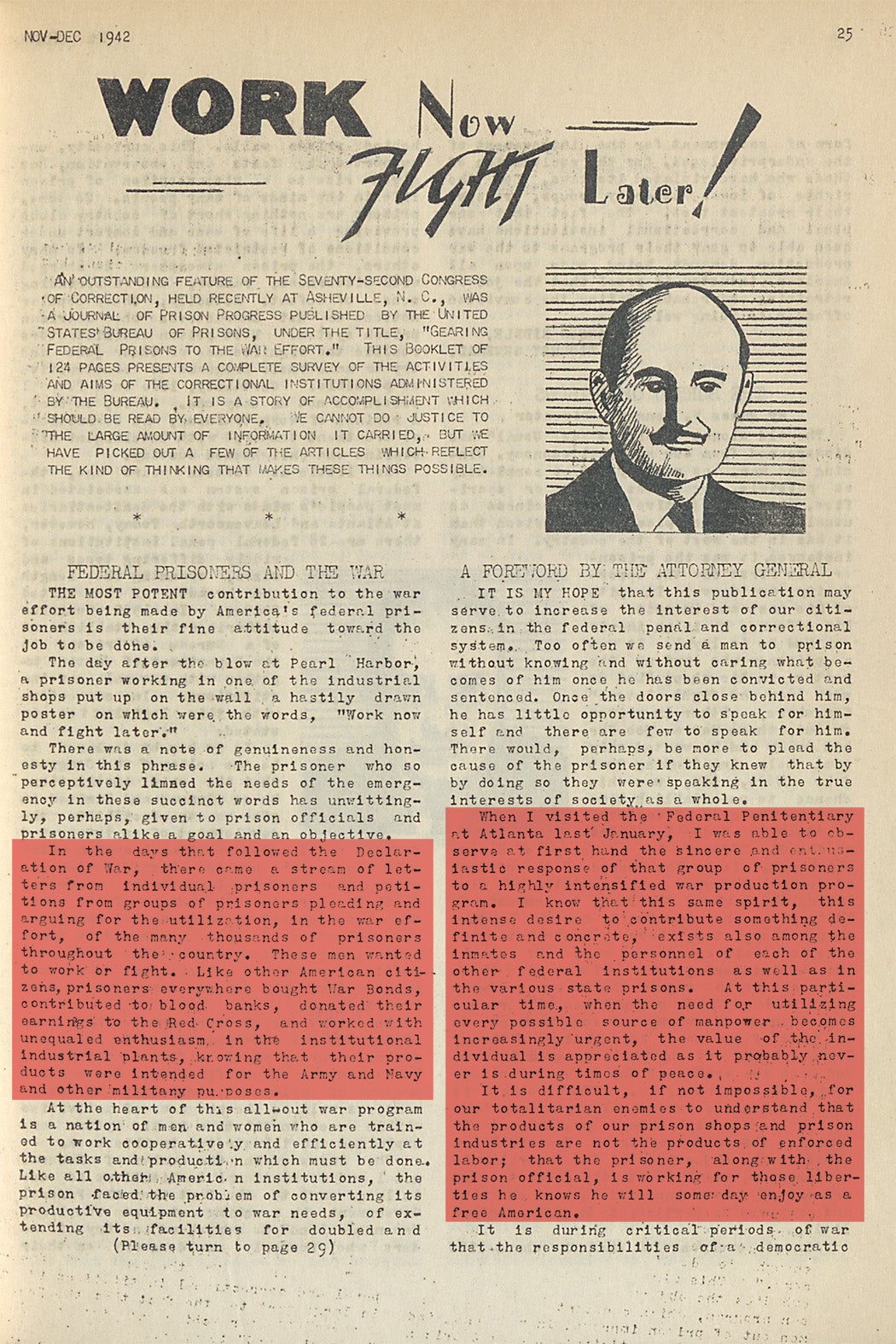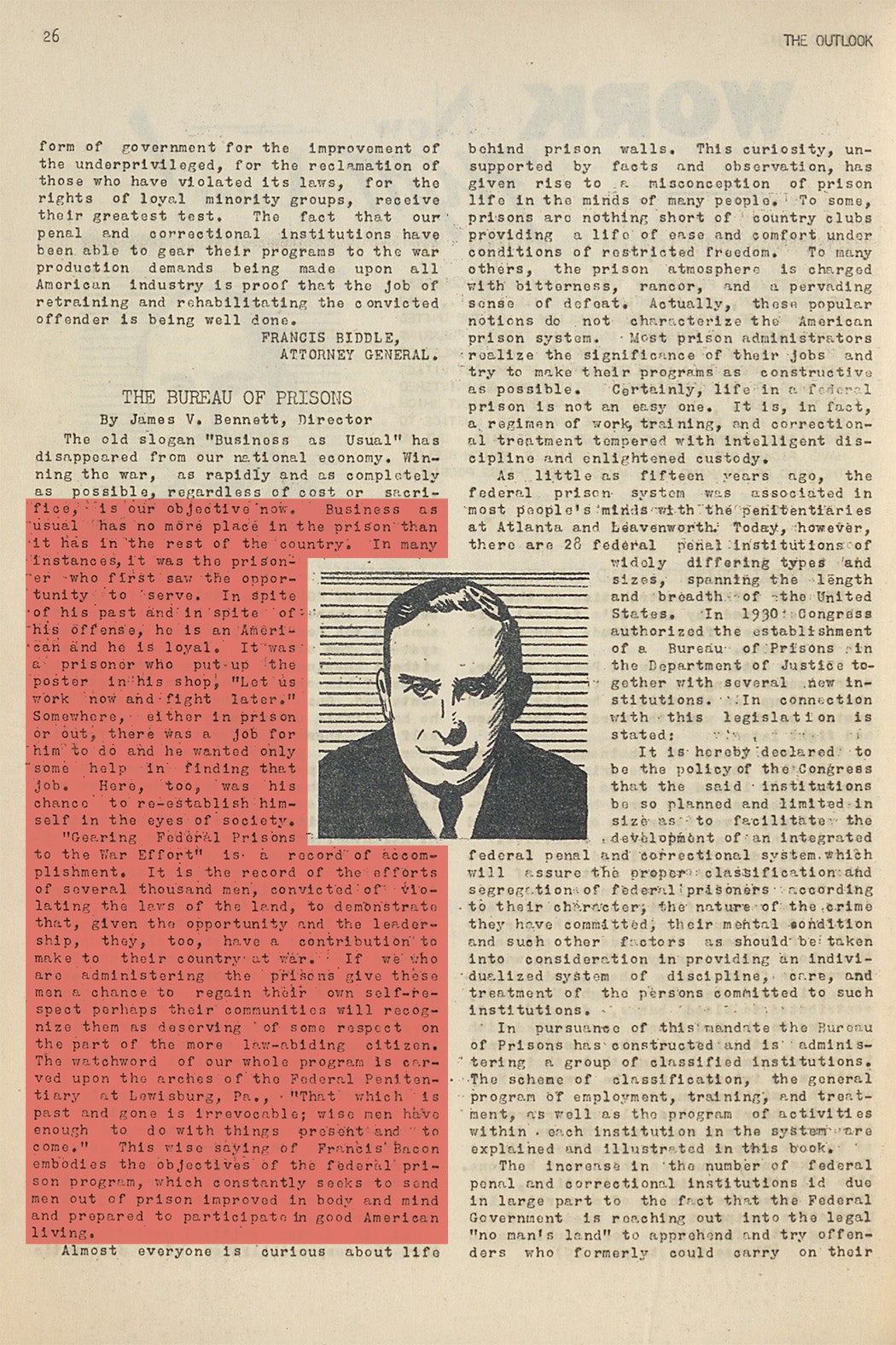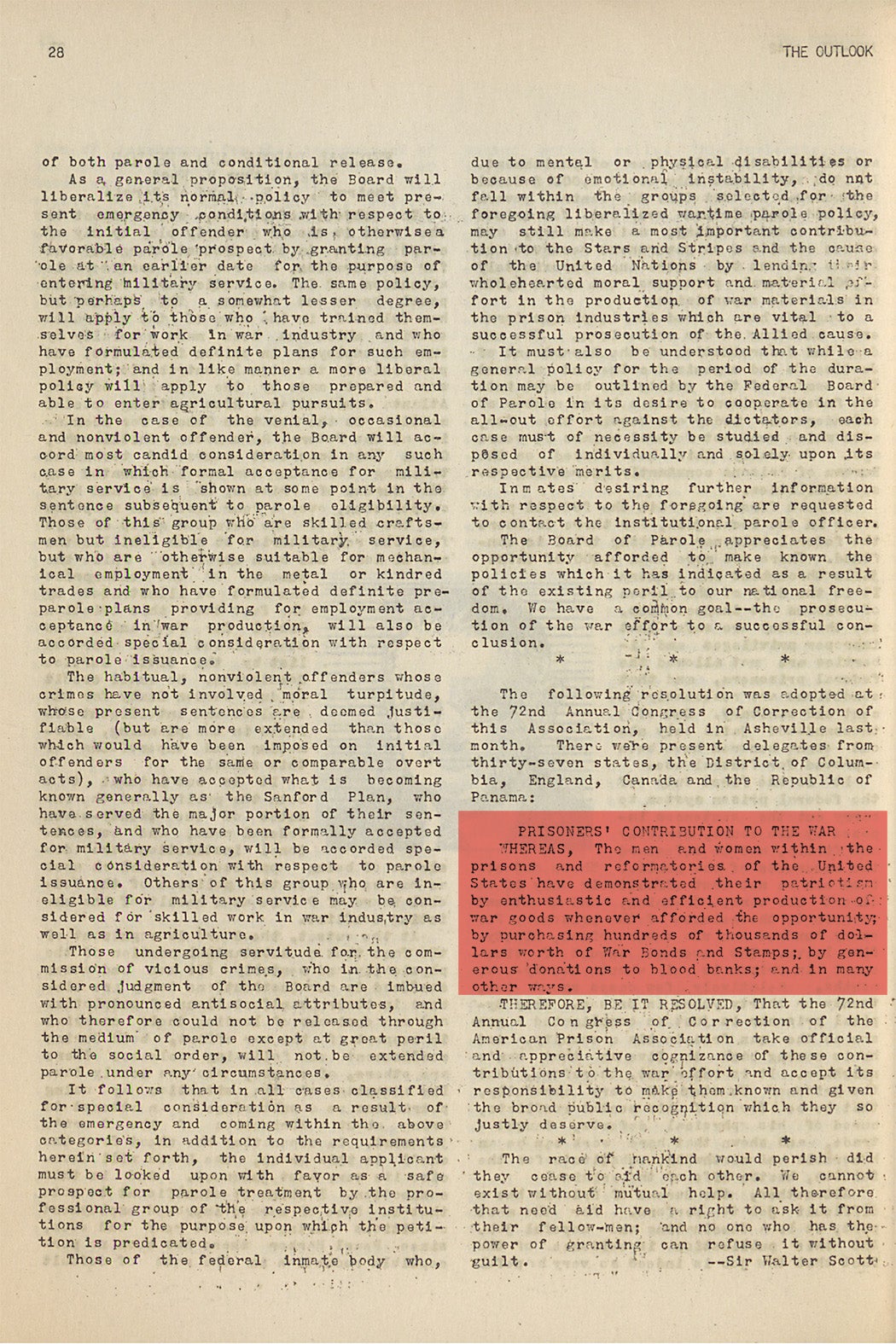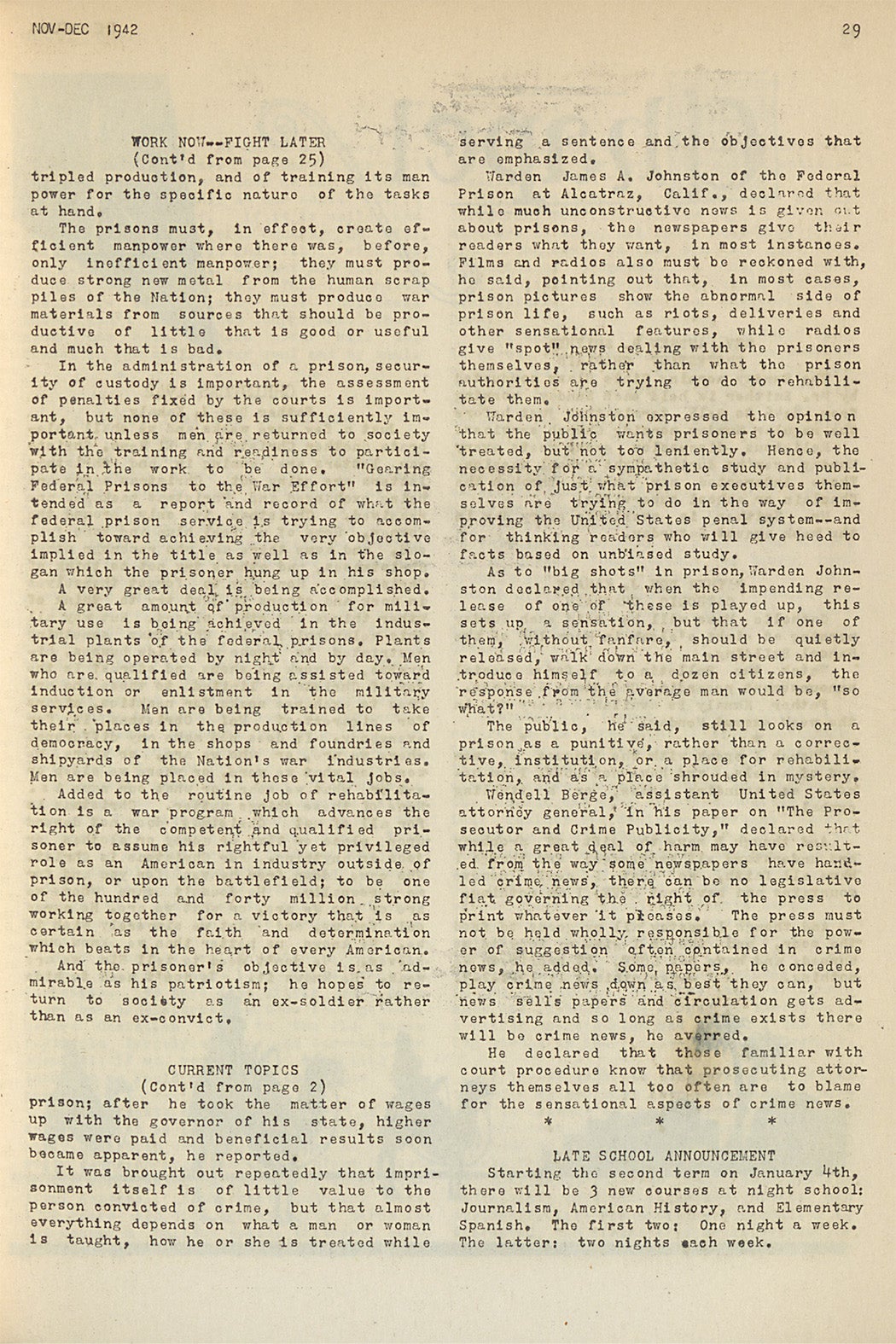A wave of patriotism swept the nation during World War II, and prisons were no exception. Within the American Prison Newspapers collection, publications of the era showcase the little-known ways that prisoners supported, or wanted to support, the war effort. The US is not known for having sent its prisoners to the frontlines to fight, unlike some other countries. The prison newspapers tell a different and more complex story, though.
From editorials proclaiming love for democracy to calls to be released from prison in order to fight overseas, the initiatives seem to have been at least partly inspired by the incarcerated people themselves. Though some correctional administrators sneered at prisoners’ patriotic proclamations, interpreting them as little more than a ploy to be released, parolees were among those killed in action. They chose risking their life to fight in the war over safely sitting out a few years behind bars. The myriad ways people in prison contributed have barely been preserved by history, but contemporary prison newspapers documented them extensively.
While only a tiny fraction of incarcerated people were able to parole to serve in the Armed Forces, even prisoners who stood no chance of being released maintained a deep desire to contribute. From manufacturing to farming to using their own resources, bodily and financial, incarcerated people found many ways to support the country during the war. Though some initiatives were surely imposed by the administration in top-down directives, prisoner-penned editorials of the time are uncharacteristically motivational.
“It is difficult, if not impossible, for our totalitarian enemies to understand that the products of our prison shops and prison industries are not the products of enforced labor; that the prisoner, along with the prison official, is working for those liberties he knows he will some day enjoy as a free American,” wrote then-Attorney General Francis Biddle. Because of the 13th amendment, his statement is not entirely true, of course, and plantation prisons in the South producing food under rationing were likely using forced labor in harsh conditions. But his point remains: a sizable share of people inside correctional institutions contributed to the war effort with something that approximated willingness.
Blood Donations
One of the most widespread ways prisoners supported the war effort was by donating blood. Perhaps they couldn’t send their body to the front, but they could send their blood. The Ohio Penitentiary, it seems, held the record for most blood donations of any prison, at 10,000 pints. (Today, due to ethical concerns around consent, fears of infectious disease, and various regulatory prohibitions, incarcerated people cannot donate blood.) The military tribunals that replaced Hawaiian civilian courts during martial law would even allow blood donations to stand in for fines and days in prison. Under power imbalances, the notion of consent becomes distorted. One must adopt a hint of skepticism when reading of prison blood drives.
“We Can Help”
In a Soonerland editorial written by an unnamed prisoner, he speaks with urgency of the need to support the very society with whom they once clashed:
…[W]e must realize that the bullwhip of tyranny is lashing across the backs of enslaved Europe. Must we feel the lash before we understand that even our smallest contribution to the war effort might have prevented it?…. Regardless of how subversive most of us have been toward the laws of our own country, the prison undertone is such that all are becoming heartened. Forgotten entirely is any previous clash with what is called society. And it is stimulating to listen to the discussions as to why we will win this war.
In Hawaii, shortly after the bombing of Pearl Harbor, one incarcerated man wrote an editorial titled, “We Can Help,” offering up the assistance of the thousands of people locked in prisons and imploring his peers to “take their places as needed workers in the vast mechanism of war whose wheels have started to revolve,” as well as for parolees to “justify their release” by contributing adequately. Though any prison press is subject to self-censorship or explicit censorship, the volume of content reflects a sincere and ample demand.
War Bonds
Prisoners across the nation were being encouraged to buy war bonds, as seen in the Indiana Boy’s School Herald. The buying of war bonds is proudly announced across many different World War 2 era prison newspapers, at times taking on a competitive tone. “The U.S. Penitentiary at Lewisburg boasts of one inmate who has singly purchased $1,300 worth of War Bonds,” a whopping sum equivalent to over $22,000 today, paid by someone deprived of their freedom and the ability to earn high wages.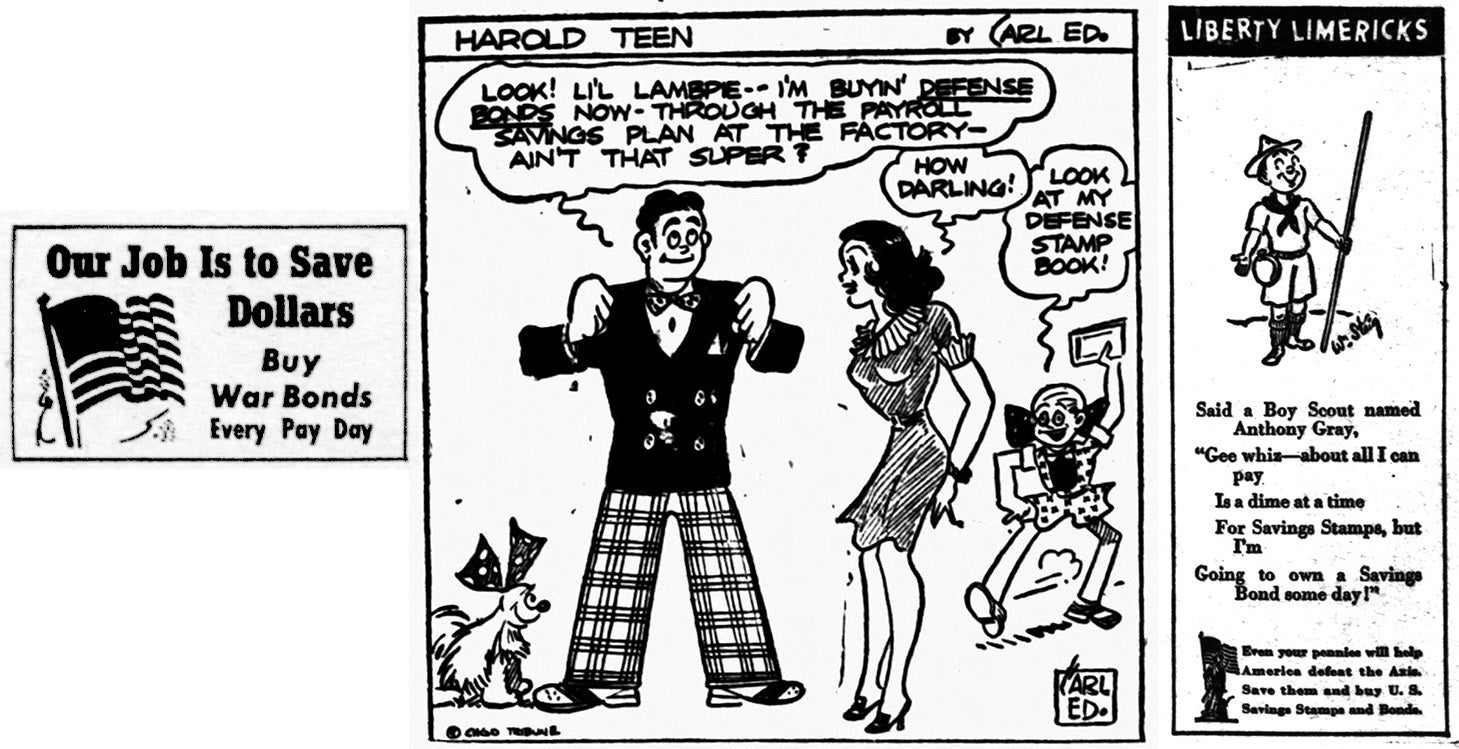
Prison Labor
For much of the 20th century, federal restrictions severely curtailed how prison-made goods could be used. The arguments against them were not necessarily based in ethical concerns for prisoners’ rights, but rather on the ways prison labor and goods had an innate, unfair advantage against the free market, chiefly that they didn’t have to pay wages. Organized labor (and even what ethical concerns existed) around the use of prison labor were temporarily sidelined with President Roosevelt’s 1943 executive order that allowed states and the federal government to procure any goods needed for the war effort from all territorial, state, and federal prisons.
Lewis E. Lawes, former warden of Sing Sing prison, is quoted in a 1943 issue of the Paahao Press as saying “prison morale is best in history,” likely referring to the fact much of the prison population was suddenly given meaningful employment, as the “idleness” that had plagued prisons since the Great Depression was seen as hurting morale. (A warden might not be the best person to judge the morale of the people in his custody.) “Prisoners are just as interested in victory as you are,” former warden Lawes proclaimed, “Proportionately, convict blood donations are far greater than those on the outside; and that war bonds and stamps are the fastest selling things in prison.”
In the same issue of the Paahao Press, nationwide prisoner war efforts are lauded, including the record-setting war bond purchase. “The Federal Prison Industries at McNeil [Prison] has been awarded a contract by the United States Army to build six 95 foot vessels.” Not all prisoner support went to the war effort, as some incarcerated people ended up fighting in the war itself. “Paroles [sic] have been granted to 691 inmates of Illinois prisons… to enable them to enter the service of the U.S. Armed Forces…”
Paroling to Fight
The law that expressly prohibited anyone ever convicted of a felony from joined the Armed Forces was modified in 1940. After a good deal of bureaucratic maneuvering, by 1943, “prison draft boards” had been established and were busily evaluating incarcerated men for their fitness to serve. In Soonerland out of the Oklahoma State Prison, Warden Fred Hunt proudly announced the protocol:
If you are within the age limits and if the offense to which you were committed do not, by reason of selective service regulations, automatically require a low classification, it shall be my pleasure to submit your names to the draft board, provided your conduct has been good.
The men that are classified 1-A will then be given physical examinations. I want you to remember that the physical requirements are rigid… Those that meet the physical requirements will be certified to the Governor by the draft board and, if approved, releases from civil custody will be issued and induction into the service will follow.
While prisoners’ contributions to the war effort were mostly forgotten to history, they were formally recognized at the time by many national leaders, including then-Attorney General Francis Biddle, Director of the Bureau of Prisons James Bennett, Chairman of the US Board of Parole Judge Arthur Wood, and a resolution at the 72nd Annual Congress of Correction, published in The Outlook out of the federal reformatory in Oklahoma. Judge Wood, Chairman of the Board of Parole, cautiously commends the pleas of prisoners to be allowed to “work or fight”:
[T]he Board is cognizant of the fact that a substantial portion of the physically and mentally fit men and women confined in our institutions today are sincere in their manifestations of patriotism and are desirous of lending their energies in support of the war effort, both during their confinement and following release. There are others, of course, who are simply using patriotism as a subterfuge in an attempt to bring about a diminution of the Court’s judgment.
In June of 1944, Oregon State Penitentiary resident Jim McCoy wrote a succinct summary of the many ways prisoners had contributed, published in Shadows:
The nation’s prison farms produced approximately $24,000,000 to the value of food during 1943, and the monetary value of its manufactured products reached nearly $14,000,0000. In additions [sic] to those contributions prisoners gave thousands of pints of blood, purchased more than $2,600,000 in War Bonds, and donated thousands of dollars to cigarette campaigns for soldiers.
Many incarcerated people desired to serve their county during World War II, whether by paroling in order to join the military or by contributing to the all-encompassing war effort in prison factories and farms across the country. The many ways prisoners supported the war were hardly recognized by historians, but are well-documented in papers across the American Prison Newspapers collection.
Support JSTOR Daily! Join our new membership program on Patreon today.



